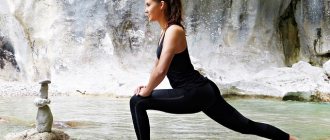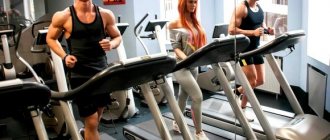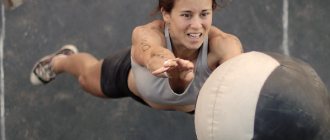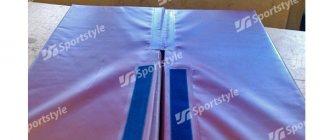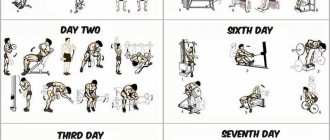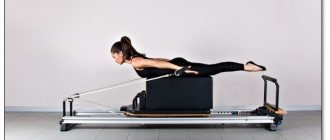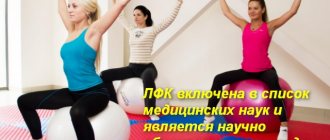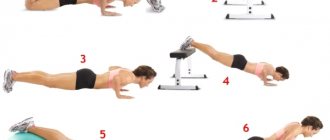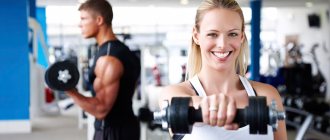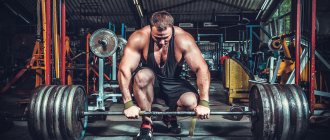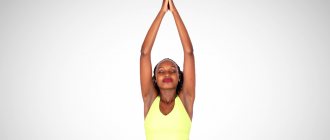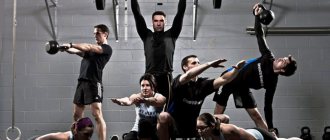Exercises for the shoulder girdle and arms
To do this, you can use a full-fledged set of general developmental physical education exercises for adults at home and make your figure more attractive and your muscles toned.
Over time, the muscles of the arms and shoulders lose their elasticity and become more relaxed, which, together with other reasons, leads to the appearance of scoliosis and curvature of posture. There are simple actions that can form a good muscle corset.
Popular site article: How to treat bloating and gas at home
Exercises for a given muscle group are performed a certain number of times in several sessions.
Before performing a set of general developmental physical education exercises for adults, you must do a warm-up.
Arm extension
The exercise is performed with dumbbells. You need to do 10 exercises at a time:
- rest your knee and one hand on a flat surface;
- straighten your back, tense your stomach, do not raise your head;
- take the dumbbell in the other hand, bend it;
- keep your elbow motionless, straighten your arm from the dumbbells;
- turn your hand palm up and fix it;
- return to the previous position.
Knee push-ups
Carry out several repetitions 30 times.
A set of general developmental physical education exercises for adults will help you always stay in shape.
Technique:
- emphasis on knees, feet crossed, raised above the floor;
- place your palms close to each other;
- pull your stomach in, bend your elbows and lower yourself to the floor;
- Slowly straighten up.
Neck exercises
A set of general developmental physical education exercises for adults is designed in such a way as to pay special attention to the muscles of the cervical spine. Strengthening and development of which is the prevention of pain and treatment of pathologies. For a sore neck, neurologists recommend performing gymnastics using static exercises. Below are some of them.
Important! If a person feels pain and discomfort while performing an exercise, you need to reduce the range of motion and reduce the number of repetitions. If pain is still present, you should postpone performing the gymnastic element for a while.
Pendulum
- take a comfortable position, keep your head straight;
- tilt to the right, strain your neck, hold your head for 7 seconds;
- tilt to the left.
Repeat movements 5 times.
Airplane
- spread your arms to the sides, holding for 10 seconds;
- lower your hands for a moment;
- repeat the spread with your hands 3 times;
- tilt your right hand so that it is higher than your left;
- change hands.
Do 2 more times, hold for 10 seconds.
Exercises for legs and pelvis
This complex allows you to strengthen the muscles of the thighs, back of the torso and buttocks.
Squat
- place your feet wider than your shoulders;
- perform a squat with your thighs parallel to the floor;
- repeat 20 times.
Lying leg raises
This exercise is the basis of a set of general developmental physical education exercises for adults, which involves the work of several muscle groups.
- lie down on a flat surface;
- bend your legs, raise them;
- the hips take a perpendicular position to the floor, the shins are parallel;
- spread your legs apart and fix them;
- slowly bring your knees together.
Perform 10 times, doing 2 approaches.
Exercises for the torso
Exercises for developing the torso muscles are usually divided into 2 groups: for the chest and for the abdomen. The main training methods are presented in the table.
| № | A set of general developmental physical education exercises for adults | Dosage |
| Breast | ||
| 1 2 3 | Raising two arms with dumbbells to the sides, in a lying position Raising your arms with dumbbells from behind your head while lying down Bench press while sitting on a bench | 2x8 2x5 3x5 |
| Stomach | ||
| 1 2 3 | Lying on your back, lift your torso, bending forward, touching your head to your knees Hanging on the crossbar, raise your legs up, fix With your feet shoulder-width apart, bend to the sides with a barbell on your shoulders | 25 6 2x5 |
Important to remember! Movements aimed at strengthening the torso affect the internal cavities of the body and important organs. They need to be done slowly, without forcing.
Lesson programs
A complex scheduled by number of repetitions and days is called a program. Depending on what goals a person pursues, his own training method is selected. As a rule, the trainer selects a set of exercises for the trainee, but after studying the necessary literature, you can cope with this task yourself.
For beginners
The program described below is perfect for beginners, while women can reduce the training time by 2 times, while halving the number of approaches. The load should be gradually increased to achieve the desired result. Fitness for beginners at home necessarily starts with a warm-up, which reduces the risk of injury, improves muscle performance and increases performance. A warm-up can include jumping rope, quick squats, running in place, swinging your arms, etc.
Recommended weight loss program:
- Monday . Pull-ups – 5 approaches, 5 rubles each. Lifting dumbbells with your arms tightly pressed to your body (working part of the arm from the elbow to the shoulder) – 3 approaches, 10 repetitions each. Classic squats with the heel pressed to the floor and a straight back - 5 sets of 20 repetitions.
- Wednesday _ Squats – 5 sets, 100 reps total. Push-ups on parallel bars with weights in the form of a backpack - 3 sets of 10 rubles. Standing dumbbell overhead raises – 4 sets, 10 reps each. Pull-ups/push-ups from the floor – three times, 5 rubles each.
- Friday . Raising your toes, holding dumbbells in your hands – 4 times, 15 repetitions. Pull-ups – three times 5 times. Squats with dumbbells – 5 times, 20 repetitions. Push-ups – three times, 10 rubles each.
Online classes at home for weight loss with music
This program is universal and is suitable for the most part for beginners, therefore, having mastered it, you will need to choose a set of exercises with a greater load. Online fitness at home is designed for classes for three months; it allows you to lose excess weight and tone the main muscle groups. You can perform the complex separately, according to the circular method, or in supersets (alternating 2 exercises) if you wish. Using various online resources, you can familiarize yourself with the correct technique for performing movements.
Select rhythmic music for fitness in advance, warm up and start exercising. In this case, it is better to combine movements, alternate and do different variations of sets, because otherwise you will quickly get bored with the workout and you will not enjoy it. Options for practicing with music:
- Jump squats . Place your legs parallel to your shoulders, squat with a straight back, moving your pelvis back, you can put your hands behind your head. Jump up while sitting. You need to repeat it 6-8 times; during your workout, do it at least three times.
- Exit at close range while lying down . Starting position – legs parallel to the shoulders, arms along the body. Lower your pelvis down into a squat, place your palms on the floor and jump back, leaving your upper body in place. Having taken the position lying down as for push-ups, come back. Repeat 8 times.
- Book . You need to lie on the floor with your arms stretched up. Then begin to simultaneously lift them together with your legs, folding them like a book. This is very effective for working the abdominal muscles. Repeat this at least 8 times, doing 3 sets.
- Jumping . You will need a step or a low, durable stool, on which you need to jump from a distance of about 40 cm. Keep your hands slightly behind, and swing them when moving forward. Do 3 times 10 repetitions.
- Kicks . Place your legs parallel to your shoulders, bend your knees slightly, and bend your arms at the elbows. Keep your fists at jaw level (like kickboxing). Strike your heel back and forth rhythmically. Do not fully extend your knee, otherwise you may get injured. Performed in 5 sets of 8-10 times.
- Size chart for men's clothing from different countries
- Abdominal ascites: causes and treatment
- Cake in a frying pan with condensed milk: step-by-step recipes with photos
With a ball
The presented complex helps strengthen a person’s muscular corset, improving his posture and working on flexibility. The gymnastic ball is also considered an excellent stress reliever for those who are often exposed to stress. The fitness program includes effective general strengthening complexes, before performing which you must warm up by jumping rope or vigorously doing squats. It is recommended to do:
- Pelvic lifts . Lie on the floor with your back, place your ankles on a fitball, straighten your knees. Next, you should raise your pelvis, rolling the ball to your buttocks, stay at the top point for a few seconds, then lower down, taking the starting position. Do 10 reps.
- Crunches . Take the same position as in the previous exercise, with the ball sandwiched between your ankles. Place your hands behind your head, begin to raise your legs together with the fitball, straining your stomach. Complete 12 reps.
- Classic push-ups . Place your palms on the floor, place your feet on the ball, and keep your back straight. Slowly perform 10 push-ups.
- Reverse push-ups . Hands should rest on the fitball with a reverse grip (sitting with your back to the ball). Lower your pelvis almost to the floor, bending your elbows, keeping your knees at right angles and slowly return up. Repeat 8-10 rubles.
With ribbon
Using an elastic band, you can provide additional stress to the muscles, and if you roll it several times, the severity of the exercise can be increased. The item is used to work out different muscle groups. The lesson may include:
- Steps . Fasten the ends of the tape to each other, put the resulting ring on your legs (at knee level). Place your legs parallel to your shoulders, squat slightly and in this position begin to take long steps forward. Repeat for 1-2 minutes, alternating.
- Hip lift . The fitness band should wrap around your ankles. Lie down on your stomach, place your hands under your chin and begin to alternately lift your legs up, while pulling on the shock absorber. Repeat the movements 20 rubles.
- Squats . Move the ring to the level of your knees, spread your legs slightly and, without bending your back, begin to slowly lower down and, as you exhale, return to the starting position. Repeat 15 times.
- Abdominal pumping . You need to stand up and straighten your legs. Take the tape in your hands, stretch it and lift it up. First, bring the right one back, turning the body in the opposite direction. Then change to the left and do the same. Perform 20-30 repetitions.
- Leg raises . Lie on your side with the tape ring around your ankles. Begin to lift your top leg, applying maximum tension to the shock absorber. Roll over and repeat the movements. Do 20 reps on each side.
Power training
The program is aimed at increasing endurance and developing strength; in addition, strength training in fitness has a positive effect on overall well-being and corrects the figure. Such training involves the use of sports equipment - barbells, dumbbells, exercise machines and various weights. The program is divided into 3 sessions, between which there should be a day of rest for muscle recovery.
- First day . The muscles of the chest, triceps and shoulders are worked. You can do a bench press with dumbbells, a horizontal press, an overhead crossover, a military press, raises with dumbbells on an incline bench, dumbbell lateral raises, overhead arm extensions, and dips.
- Second day . Squats, deadlifts, lunges, and crossover leg abductions are ideal for strength training. It’s better to do it with weights.
- The third day . The back muscles and biceps work. Suitable fitness exercises would be shrugs, various rows (to the chest, bent over, etc.), hyperextension, forward bends, and curls with dumbbells/barbells.
Full Body Exercises
The basis of the complex of movements for the whole body is 3 exercises:
- bar;
- squats with weights;
- incomplete bridge.
Plank
The plank is a strength exercise that puts stress on all muscles.
Find out how to improve your health: What vitamins are best for adults to take for immunity?
To perform a plank, you need to position yourself on the floor so that you support your body on your elbows and toes. You need to hold this position for 1 minute in several approaches.
Squat with weight
This exercise pumps up the muscles of the lower part: thighs, calves, buttocks. You can use dumbbells or another object as weight. For beginners, it is recommended to start squats without using weights. In this case, you cannot lift your heels off the floor; start from 10 times in several sets.
Technique:
- place your feet wider than your shoulders;
- lower yourself until your buttocks are parallel to the floor;
- slowly return to the original position.
Incomplete bridge
This exercise allows you to strengthen the muscles of the thighs and buttocks:
- lie on your back;
- lift your pelvis up without leaning on your elbows;
- hold for 30 seconds;
- fall to the floor.
The best exercises for losing weight throughout the body
Initially, it is important to remember that to lose weight you need not only to exercise, but also to eat right . Experts consider the best time for exercise to be in the morning, when the body actively burns fat. But if it is not possible to study in the morning, you can do it in the evening. It is only important not to perform exercises on a full stomach - let at least a couple of hours pass since your last meal.
It is important not to focus only on problem areas, but to solve the issue comprehensively. The suggested full-body workout at home includes ten movements that need to be performed in three sets of 15 repetitions. If done regularly, you will see results after a few months.
Now let's look at exercises for the whole body, which must be performed exactly in the proposed sequence , working the torso from top to bottom.
Neck exercises
First, a full-body workout involves working out the neck, which is aimed at eliminating the double chin and rejuvenating the skin of the neck. This is important because these points tend to visually age.
You need to straighten your chest, place your hands on your shoulder joints. Begin to pull your neck as high as possible, while pressing your fingers on the shoulder joints so that they remain motionless. Inhale and count to ten, then exhale. Do 15 repetitions of the movement.
Lower your arms along your body, relax it. Tilt your head forward and smoothly turn it to the left, bending your neck. Then bend your head to the right and lower it to your chest again. Do the same in the opposite direction.
The following movement will also be effective. Place your hands above your chin. Overcoming their resistance, open your mouth. Repeat the movement 15 times.
Hand exercises
Next, training the whole body in one workout involves exercises for the arms, with which you can eliminate excess fat in the upper part of the shoulder. To do this, you need to work your biceps and triceps using dumbbells weighing 1-2 kilograms.
Place your feet shoulder-width apart and hold dumbbells in your hands. Perform arm curls, doing 20 reps for each.
For the second movement you need a chair . Sit on it, take a dumbbell in your hand and do curls at a slow pace.
The third exercise is also done in a sitting position. You need to hold the dumbbells in your hands, then begin to move upward, completely straightening the shoulder joint in the uppermost position of the trajectory. Move slowly. Repeat the exercise 15 times.
Exercises for chest muscles
Exercises for an ideal body, aimed at the pectoral muscles, will help visually lift your breasts. In women, it mainly consists of fatty tissue, and there is little muscle there, so you won’t be able to exercise the size and shape of your breasts, but you can lift it and make it more elastic.
You will need a chair or exercise ball. You need to take a lying position on your upper back, supporting your body with your legs bent at the knees. Hold the dumbbells in straight hands and place them between each other. Smoothly lower them as low as possible behind your head. As you inhale, lower your arms, and as you raise them, inhale. Do four sets of 12 reps.
Exercises for abdominal muscles
A full body workout at home can't help but involve your abs.
You need to take a lying position on your back, bend your legs at the knee joints. Place your hands behind your head, place your feet next to each other. Raise your torso towards your knees so that your lower back does not lift off the floor. Do three sets of 30 reps.
Take a supine position again, stretch your arms along your body, bend your legs at the knee joints and place them so that your thigh is perpendicular to the ground. Begin to pull your knee joints towards your chest so that your pelvis is completely lifted off the ground. The number of approaches and repetitions is similar to the previous exercise.
Waist exercises
Place your palms together and bend to the sides. Do the exercise slowly while keeping your back straight. Also make sure that the body tilts clearly vertically. Do two sets of 15 reps,
Place your feet at the level of your shoulder joints, place your hands on your waist. As you inhale, bend forward, keeping your back straight. Once you reach the bottom position, pause for a couple of counts and return to the starting position. Do two sets of 15 reps.
Exercises for buttocks and thighs
Take a sitting position on the floor, keeping your back vertical. Engaging the muscles of your thighs and buttocks, rise into chair pose, supporting yourself with your arms. Hold in the upper position for half a minute. You need to do 30 repetitions.
The next movement is called “swallow”. Having assumed a standing position, swing your right leg back, while moving your body weight onto your left leg and tilting your torso forward. Stay in this position for half a minute, then return to the starting position. Do the same for the second side. Do two sets of 40 repetitions for each leg.
These exercises for a toned body will help give your hips and buttocks a beautiful shape and eliminate all excess from these areas.
Leg exercises
These exercises for a slender body will allow you to work out your legs, make them slim and toned, and eliminate the appearance of cellulite.
Take a lying position on your back, place your arms along your body. Raise your body until only your head, feet, shoulders and elbows touch the ground.
A very effective movement for the leg muscles is squats. You need to lower yourself until your thighs are parallel to the floor. To complicate the movements, you can use dumbbells.
Muscle stretching exercises
Once you've completed your full body exercises, stretch your muscles. In each position you need to linger for 10-30 seconds so that the tension in the muscles disappears completely.
Place your feet slightly narrower than shoulder level, bend your knees slightly. Raise one arm and reach as high as possible. Do the same in the other direction. Complete six reps.
Stand with your back to the wall, rest your palms on it. Begin to squat smoothly, holding this position for 20 seconds. Repeat the exercise six times.
The proposed exercises for a beautiful body are simple and accessible to everyone. Do them regularly, and you will soon notice clear changes for the better. But remember that if you want to lose weight, it is also important to eat right. Adjust your diet, and combined with physical activity this will give amazing results.
How to exercise properly at home
Exercises to develop posture
Good posture not only makes a person more attractive, but also affects the proper functioning of all vital systems. To create an even posture, you need to perform the following exercises.
Reed:
- sit on your knees, clasp your hands above your head;
- Turn your hands palms up and pull them as high as possible towards the ceiling;
- bend to the sides;
- return to original position.
When doing this, keep your back straight and do not bend your elbows. Do it 4 times.
Worm:
- sit on your heels, place your hands on your knees;
- spread your knees to the sides;
- bend your elbows and lower them to the floor;
- tilt your head and hold for 10 seconds.
Repeat – 3 times.
Balance exercises
An additional set of general developmental movements in physical education for adults, which is aimed at correcting posture, includes balance gymnastics. Such exercises strengthen the muscles of the torso and increase the tone of the spinal muscles. They are performed on a raised support or on the floor, and can be done on the spot or in motion.
Exercises in place: stand on toes, on heels, turns, moving limbs, jumping.
Movement exercises: walking of various types, using weights while walking, overcoming obstacles, running, dance steps.
Strength exercises
Strength actions are aimed at training physical strength and endurance with the participation of certain muscle groups. They are usually divided into training with your own weight and with free weight. Exercises are performed in the morning or afternoon 10 times, several times a week.
With own weight:
- push-ups;
- pull-up;
- squat.
Note! In order for the load to be distributed evenly across all muscle groups, a set of general developmental physical education exercises for adults must be done with a straight back and correct body position: put your feet shoulder-width apart, and do not lean forward.
With weights (raising and lowering projectiles):
- barbell squats;
- chest presses;
- bent over row;
- deadlift.
Complex exercises for the whole body, exercises with breathing. The benefits and rules of breathing exercises
Breathing is one of the most important functions of the human body. Unfortunately, few people attach importance to it. But many teachings, in particular Eastern ones, pay attention to various types of breathing exercises and breathing techniques, by performing which you can rejuvenate, become healthier, lose weight, recharge with energy, or, conversely, relax. Traditional medicine also recognizes the benefits of breathing exercises. It is recommended as an auxiliary method of treating diseases of the respiratory organs, cardiovascular, irregular and musculoskeletal systems, and many other ailments. The benefits of exercises, by performing which you can learn to control the frequency, depth and rhythm of breathing, are as follows:
- Hypoxia of the body is prevented.
- Lung volume increases. The respiratory organs are sanitized.
- Oxygen is actively supplied to the blood through the lungs, and metabolic processes within the body are accelerated. The skin becomes more elastic and firm, its color improves.
- The brain receives the nutrition it needs, nervous processes are stabilized (headaches go away, nervous tension subsides, etc.).
- A particular breathing technique uses different muscle groups. Their tone improves and fat deposits are reduced.
Breathing exercises for energy and weight loss are done in the morning. This time of day is considered the most favorable due to the biorhythms of the human body. Immediately after waking up, breathing is still depressed. Through exercise, you can activate this and all other functions of the body. Before you start doing the exercises, you should learn the rules of breathing exercises.
- Breathing exercises for weight loss are performed on an empty stomach or at least two hours after eating. This is another explanation that it is better to do it in the morning.
- There must be fresh air in the room. It is advisable to open the window.
- There should be no distractions to perform the exercises. Gymnastics cannot be done with the TV on. Only quiet music for meditation is allowed.
- The clothing that the person performing the exercises is wearing should not hinder movement.
- During breathing exercises, you need to concentrate on your actions and sensations.
- At first, it is recommended to perform exercises in front of a mirror in order to understand what is happening to the body at this time.
Breathing exercises
Such exercises help you relax, lose weight, normalize digestion, and fight stress.
Palms
Take 4 deep breaths through your nose, exhale quietly through your mouth. As you inhale, clench your fists. Pause for 6 seconds and lower your arms. Shoulders and stomach are relaxed. You should do 24 sessions of 4 breaths.
Pump
While standing, bend down. In the middle of the tilt, inhale air through your nose, ending the inhalation along with the tilt. Straighten up. Repeat 12 sets of 8 breaths, taking a break for 4 seconds.
Shoulder straps
Stand on the floor, press your hands to your stomach. When performing, take 8 breaths in a row. The break is 4 seconds. As you exhale, push your hands towards the floor, straightening them. As you exhale, press your hands again. Repeat – 12 sets of 8 breaths.
Stretching exercises
After completing a set of general developmental strength exercises, an adult must stretch his tendons and muscles. Over the years, stretching becomes worse, in addition, strength training contributes to the shortening of ligaments and deterioration of joint mobility. Stretching exercises should be done without pain, jerking, and breathing deeply.
First, large muscle groups are pulled, then small ones.
Stretching the back and hips
Sit on the floor, make sure your back is straight, legs stretched forward. To stretch the muscles, you need to lean forward and try to reach your toes with your hands. Touch your feet and hold for 10 seconds, then straighten up. You need to lift one leg and, grabbing it with both hands, pull it up. If you feel tension, fix the position for a few minutes and change your leg.
Chest stretching
The exercise is performed in a standing position, legs should be shoulder-width apart, knees bent slightly. Place your hands behind your back in a lock. You need to slowly stretch your chest forward to the maximum, straining your stomach and back.
Relaxation exercises
When performing monotonous work, a person does not notice how his muscles, while maintaining a certain body position, are constantly tense. To restore strength and calm your nerves, you need to relieve tension. For this purpose, programs have been developed that help you relax and relieve fatigue.
You need to perform the exercises with holding your breath and tensing your muscles.
For hands
Standing straight, raise your hands clenched into fists. When inhaling, first strain the muscles of the hand, then the forearm and shoulder. Hold your breath for a few seconds. In this case, you need to mentally give the command for maximum tension. As you exhale, relax, lower your arms and make several pendulum-like turns.
For the torso
Lying on your stomach, bend your whole body, raising your knees and head. Starting position, relax. Do 3-4 repetitions. The second part of the exercise is performed in the same way, but you need to lie on your back. Tighten your muscles when bending, relax, straighten up on the floor.
Video exercises for a flat stomach at home
A flat stomach and sculpted abs are real. You don't have to spend money on a gym membership to do this. You can study at home at a time convenient for you. To quickly reach your goal, you need to strictly follow three principles:
The first principle is motivation. You must clearly understand that a beautiful body is achieved with great perseverance and work. No one but yourself can force you to study. Remember, your main motivation is a beautiful healthy body.
The second principle is regularity. To remove extra centimeters in the abdominal area, make it a habit to regularly perform simple exercises. If you have just started exercising, they may seem difficult. But already from the second or third workout, your muscles will get used to the load, and exercising will become easier and more enjoyable.
The third principle is proper nutrition. To have a beautiful figure, training alone may not be enough. It is necessary to be aware of healthy eating and follow a diet.
Now look at what exercises you need to do to make your stomach flat:
While doing the exercises, pay attention to your technique. Read more about how to pump up your abs correctly and effectively.
Add light jogging before exercise routines. Running improves blood circulation, strengthens the heart and blood vessels, and helps burn excess fat. Read our recommendations on how to start running , how to run in winter and what natural running technique .
General developmental exercises in pairs
Outdoor exercises in pairs are aimed at strengthening joints, developing strength and endurance. Movements in pairs work muscle groups in a special way that cannot be achieved alone.
Any set of general developmental physical education exercises for adults in pair work helps to learn how to calculate efforts to resist a partner and demonstrate your maximum abilities. The peculiarity of such exercises is that they can be performed alternately or together, with or without objects.
For hands
Facing each other, the partners extend their arm forward, bend the other at the elbow and lock it with their partner’s arm. The training is aimed at bending and extending the arms against resistance.
For legs
An effective exercise for working the thigh muscles is quite simple. In this case, you need to lie on your back, lift and spread to the sides. At the same time, the partner stands on the side of the legs and holds his partner by the ankles. The task of the first participant is to bring his legs together, and the second one is to hold them, providing resistance. After several repetitions, the task is reversed.
General developmental exercises in motion
Such trainings selectively affect certain muscle groups and are divided into anatomical groups, which have several exercises of a local nature. ORG consists in the development of motor qualities: turns, flexion, abduction and others.
Foot and lower leg training:
- raising on toes, walking, jumping (using two or one leg);
- walking on the outside of the foot;
- touching the heel of one leg to the floor while lunging forward with the other.
Full body workout (repeat 5-6 times):
- alternate squatting and lying down;
- spread your legs, perform circular movements with your body;
- lower yourself to the floor with your legs crossed, then lie down, sit down and stand up, without using your arms.
Full body workout: what exercises to include in it
There are several options. You can make a lesson out of functional exercises. You will find options for such training here and here.
Suitable for full body and multi-joint exercises. “They will help improve muscle and heart endurance, strengthen problem areas - buttocks, triceps, abs,” says Alexandra Kushkevich, territorial manager of group programs and instructor of the Territory Fitness network . — They are also good for losing weight: exercises that involve many joints and muscles are quite energy-consuming, as a result, the pulse rises and the fat burning process starts. But remember: if you want to lose weight, then leave a pause between approaches of no more than 1.5-2 minutes so that the fat burning process does not stop.”
We asked Alexandra to compose and show us a set of such exercises. It included squats, lunges, dumbbell rows, abdominal crunches, etc.
Corrective gymnastics exercises
Corrective gymnastics is aimed at relaxing muscles and restoring normal functioning of the body. This occurs when performing general developmental, corrective and relaxing gymnastics twice a day for 15-20 minutes.
Such exercises may include:
- a set of general developmental gymnastics exercises for adults using gymnastic apparatus;
- a series of movements without projectiles;
- group or individual lessons.
An example of such gymnastics is symmetrical exercises , which are designed to remove asymmetry, straighten the spine, and weaken muscle tone.
Exercises:
- I.p. lie on your stomach, stretch out your arms. Raise your head and shoulders, extend your arms, and move them back. Take a breath, accept and... P.
- I.p. lying on your back, raise your legs, making an angle of 45 degrees and cross your straight legs - “scissors”.
- I. p. - the same. Make circular movements of straight legs - “bicycle”.
Training plan for girls in the gym: what are the features?
It all depends on your goal - whether you want to slightly tighten your figure or, conversely, add volume to your muscles. This can be achieved with the same exercises, but the training regimen will be different. “When working on muscle mass, we work in strength training mode: that is, with a weight of 80% of your one-repetition maximum,” says Anastasia Yurkova, master trainer of the group programs of the federal network of fitness clubs X-Fit. - In this case, we perform each exercise 3-4 repetitions in 3 approaches.
If you are interested in muscle tone (which is what most women come to the gym for), you need to work with less weight - 50% of your one-repetition maximum. We perform each exercise for 15-20 repetitions in 3 sets or do circuit training.” How to choose the weights you need? “This can only be done empirically. Take some average weight and see how many repetitions of one exercise you can do with it,” explains Anastasia Yurkova. — The last repetition must be given through effort. For example, I take a weight of 15 kg and do 20 squats with it. If, when performing the last repetition, I feel noticeable fatigue in the muscles, then this is my working weight. If on the last rep I feel like I can do a few more, I need to take more weight.”
General developmental exercises with weights (dumbbells)
Exercises with dumbbells are classified as general developmental athletic training , which are aimed at training endurance, joint flexibility, and improving body proportions. Many movements with dumbbells are performed in a sitting or lying position, which reduces the load on individual parts of the body and organs.
The main rule of such exercises is a gradual increase in resistance. In this case, the actions are performed with adding weight to the dumbbells while increasing the repetitions.
Set of movements:
- lateral bends while standing with dumbbells in hand;
- pulling a projectile from behind the head while lying on a gymnastic bench;
- alternately raising your arms with dumbbells in front of you;
- lunges and squats with dumbbells.
| MedBookAide - a guide to the world of medical literature | |||||
| Sections of the site | Authors | Search | Contacts | Consultations | ☺ |
| Free medical consultation by phone Free legal consultation by phone Affiliate program (earn money on the Internet) About the Library website Anonymous free medical consultation by phone Free legal consultation by phone Affiliate program (earn money on the Internet) | ☺ | ||||
| ☺ | |||||
| ☺ | |||||
Weiner E. N. — Valeology: Textbook for universities
15
| <<< Back | Content | Next >>> |
Cardiovascular system and blood. The best means for training these systems are cyclic exercises: running, walking, swimming, skiing, cycling, etc. The main mode of their use should be aerobic, that is, one when the oxygen demand for muscle work under these conditions is completely satisfied during the work itself and an oxygen debt is not formed. The duration of continuous aerobic exercise should gradually reach 40-60 minutes with at least 3-4 sessions per week.
Long-term low-intensity exercise promotes many beneficial effects. Thus, the number of red blood cells in the blood increases, which leads to an increase in the oxygen capacity of the blood, that is, each unit of blood volume can carry a larger volume of oxygen and carbon dioxide. It is important that old red blood cells are destroyed faster, and instead of them, young ones appear, the hemoglobin activity in which is higher. Another result of long-term aerobic exercise is a decrease in the concentration of cholesterol in the blood, which is an important factor in the prevention of atherosclerosis. At the same time, atherosclerotic plaques that have already appeared on the walls of blood vessels are gradually destroyed and washed away, due to which the vessels become elastic and provide good blood supply to tissues and organs - this is an important factor in stabilizing blood pressure. It has already been proven that full physical activity activates the anticoagulation system of the blood, which prevents the formation of intravascular blood clots, including myocardial infarction.
In the heart, under the influence of low-intensity exercises, capillarization improves, that is, more blood flows per unit of myocardial cross-section, which not only provides a better energy supply for the heart, but also prevents the occurrence of ischemic phenomena and myocardial infarction in it. It improves the course of metabolic processes and activates respiratory enzymes, normalizes the ratio of potassium and sodium ions, which improves the contractile function of the heart. When aerobic exercise is combined with short-term (depending on age - from 20 seconds to 2-3 minutes) anaerobic or aerobic-anaerobic accelerations, a gradual increase in cardiac performance occurs, in particular, stroke volume (the volume of blood ejected by the heart in one contraction). In this case, at rest the heart works very economically (the frequency of contractions decreases to 50-40 or lower per minute), and when performing strenuous work, its performance in an athlete turns out to be much higher than in an untrained one (since, during work, the former’s heart can pump up to 25-30 liters of blood per minute, and for the second - only 15-18 liters).
Important factors in optimizing blood circulation are the “muscle pump” and the “peripheral muscle hearts”. The first of them is that skeletal muscles contracting during work compress the venous trunks (especially in the lower extremities), which, if they have valves, helps push blood towards the heart. The latter are realized by high-frequency vibration of medium- and small-caliber arteries, which also carry out the movement of blood, but now to the capillaries, and from there through the veins. It is important that after muscular work, vibration activity remains for several hours, and with physical inactivity it turns out to be very sluggish.
The use of cyclic exercises of a predominantly aerobic nature also has a beneficial effect on the condition of the respiratory system. First of all, it should be noted the training of the respiratory muscles, especially the inspiratory muscles, the strength of which increases noticeably. Both the elasticity of the lungs and the lumen of the airways increase. Training ensures an increase in vital capacity of the lungs (VC) and the efficiency of gas exchange (O2 and CO2) between the alveoli and the blood of the capillaries. At rest, O2 consumption, respiratory rate and the volume of air ventilated through the lungs are lower in a trained person than in an untrained person, and during hard work it is noticeably higher. An important effect of physical training is that moderate dynamic load provides better expansion of the lung tissue, more uniform blood flow in it, and active gas exchange prevents the development of congestion that provokes the occurrence of pneumonia.
Thus, the “margin of safety” between rest and maximum performance for the cardiovascular and respiratory systems is noticeably higher among those involved in physical education than among those who do not.
Central nervous system. Maintaining a good state of the central nervous system requires the use of a wide arsenal of tools.
The strength of nervous processes is cultivated through strength and speed-strength exercises (working with weights, gymnastic exercises, throwing, jumping), which require maximum concentration of the excitatory process in short periods of time. At the same time, the frequency and amplitude of impulses of spinal cord motor neurons increase, which ensures intramuscular coordination and the inclusion of the largest number of motor units. An adequate selection of the “necessary” muscles for a given movement and turning off the “unnecessary” ones is carried out due to the complex reciprocal (mutual) coordination of excitation and inhibition, which ensures the so-called intermuscular coordination. Thus, thanks to strength and speed-strength exercises, the main indicators of the functioning of the central nervous system are improved - balance, strength and mobility of nervous processes. Outdoor and sports games, hardening and other intensive means have a similar effect. To maintain an optimal state of the central nervous system, endurance exercises—cyclic low-intensity exercises—are effective. Their influence is manifold. Thus, under the influence of physical training, closed capillaries in the central nervous system open and the lumen of functioning capillaries increases (which is especially important - this occurs to the greatest extent in the frontal lobes of the cerebral cortex; perhaps this is what can explain the feeling of pleasure that appears during physical activity). In addition, continued work in conditions of increasing fatigue requires the manifestation of appropriate strength of nervous processes. It should be noted that when performing such a load, stress hormones are destroyed in the central nervous system and in the muscles - this is especially important in conditions of an extremely high density of information that a modern person must perceive and process.
Musculoskeletal system. Depending on the specific tasks set to achieve a high level of state of this system, the choice of means turns out to be specific. Thus, to obtain a strength effect, one should preferentially use strength exercises with weights reaching 70-90% of the maximum possible. These same exercises, together with speed-strength exercises, when the weight reaches 30-50%, contribute not only to the accumulation of energy potential in the muscles, but also to the strengthening of bones. At the same time, ensuring good joint condition requires solving two problems:
- maintaining adequate trophism (tissue nutrition) of intra-articular structures, for which the best means are exercises in conditions of unloading the joint itself (or at least without weights) with repeated repetitions - a bicycle for the knee joints, in a lying position or in water for the joints of the spine etc.; - achieving the strength of soft tissues that strengthen the joint (ligaments, muscles, tendons) - strength and speed-strength exercises, but, if possible, in an initial position that excludes vertical loads (for example, lying, hanging, knee-wrist position etc.). In addition to these functional systems, where the effects of physical training are obvious, some more should be mentioned. Thus, properly organized physical exercises normalize the activity of the gastrointestinal tract: gastric and intestinal juice secretion, the activity of digestive enzymes, motor activity, etc. Regular physical exercise, accompanied by sweating, not only improves thermoregulation, but also ensures the systematic removal of waste substances formed in the process of life from the body. Finally, a direct relationship has been proven between the state of physical performance and its other forms, in particular mental, and the stability of mental functions.
Thus, correctly selected and optimally planned physical activity helps to maintain a high functional level of all physiological systems, ensures sufficient general and special performance, makes human life more economical and, finally, prevents the development of many pathological processes in the body.
4.4.2. Principles of physical training
Achieving positive results with regular physical exercise is possible only if certain conditions are met, which are expressed in the form of didactic principles. The main ones among them should be considered the following.
The principle of consciousness and activity assumes that a person engaged in health-improving physical education is well aware of the need for movement to maintain a high level of health and understands the physiological mechanisms of the influence of physical exercise on the body. With this approach, the athlete, firstly, strives to learn as much as possible about his body and ways to maintain health; secondly, he knows how to develop a program of health-improving physical education in his life and plan the rational use of various means of physical education to solve general and specific problems of ensuring health; thirdly, based on the current analysis of the state of his body, he makes timely adjustments to the program and organization of health-improving physical education.
The principle of systematicity and consistency asserts the need for a certain system in the use of physical education means, which would ensure the solution of the main tasks and the achievement of health, realized through physical exercise. Practice shows that most often an athlete gives preference to any one or a group of similar means (health-improving running, swimming, games, etc.), however, limiting physical activity only to them cannot provide solutions to all problems of achieving health1.
The principle of consistency means that you cannot endlessly change the means used (at the first stages of initiation into health-improving physical education, this is permissible until the practitioner finds the most suitable physical exercises for himself). The selected means must be used in a specific system and sequence, which will allow not only to consciously plan the load, but also to monitor its effectiveness for a particular life system.
1 For example, when doing recreational jogging, a good state of the cardiovascular and respiratory systems is achieved, but this cannot prevent (and sometimes provokes) the appearance of disorders in the musculoskeletal system (spine, foot, knees) and in the immune system.
The principle of gradually increasing the load follows from the dynamics of post-work recovery of body function. The changes resulting from the load performed have certain characteristics determined primarily by the work performed. In this case, after repeated work, which has the same indicators of volume, intensity and duration as the previous ones, the same type of post-work changes will arise. If this physical training regime is maintained, the body’s adaptation to stress develops, and functional indicators do not increase. At the same time, an increase in workload (in particular, during the period of supercompensation) contributes to progressive changes, expressed in the activation of protein metabolism, and in the improvement of the activity of the central nervous system, and in the economization of functions, etc. Of course, we are not talking about increasing the load literally in every lesson, but about the tendency to increase it over a certain time cycle, for example, a calendar year.
The principle of individualization assumes that the organization and content of physical training must correspond to the characteristics of a given person. This applies primarily to its genetically predetermined characteristics. In particular, one should take into account the body type, the predisposition of a given morphotype (asthenic, normosthenic, hypersthenic and intermediate types) to certain diseases, the prevention of which should be oriented toward physical education. Another important genotypic factor is the type of higher nervous activity, for which motor means must be selected. In addition, it is necessary to take into account the characteristics of blood coagulation, the predominant type of autonomic nervous regulation, etc. In addition to genetically determined qualities in the organization of physical education, one should take into account the characteristics of the marital status of the athlete, his professional affiliation, work schedule and many other factors.
The principle of complexity of impact follows from that discussed in paragraph 4.4.1. the specifics of the influence of certain physical exercises on various body systems. Unlike sports training, where the goal of narrow sports specialization is achieved, general strengthening of the body in health-improving physical education requires the use of a wide arsenal of motor means (this provision will be discussed in more detail in paragraph 4.5.2.). The training effect can be achieved with any exercise. However, in this case, firstly, the specific effect of this exercise is manifested to a greater extent without a noticeable positive effect on other functional systems, and, secondly, the negative influences, which to one degree or another are inherent in almost any exercise, are not compensated or leveled out by other means. Thus, the full achievement of health goals dependent on physical exercises - physical fitness, physical health and physical development - is achieved only with the integrated use of motor aids.
The principle of reversibility of training effects is manifested in the fact that the latter gradually decrease as training loads decrease or completely disappear when training is completely stopped (detraining effect). A decrease in performance occurs earlier, the higher its level, but in any case, 3-8 months after stopping training, a person’s level of physical fitness turns out to be almost the same as it was before the start of regular training. True, it should be noted that due to the preservation of trace phenomena in the motor dynamic stereotype, the restoration of performance upon resumption of training in such people is more active than in those who have not previously engaged in physical education.
4.4.3. Concept of load
Not every systematic physical activity can be considered as training, since an increase in the functional capabilities of the body, that is, training effects, occur only if the training load reaches or exceeds a certain threshold value.
Speaking about the load, it should be characterized from two points of view: as the amount of external work performed and as the reaction of a given organism to the work performed.
1. The amount of external work performed by a person is determined by its intensity, duration and frequency, which together characterize the volume of the load. The first of these indicators - intensity - is determined by the amount of energy expended by the body to perform work per unit of time. The duration of the load is determined by the time it is performed and is inversely dependent on the intensity. The frequency, or repetition, of training loads (both in a separate lesson and the lessons themselves) is also in a complex relationship with other characteristics of the load and depends on the goals of the training process, the contingent of students and the type of lesson.
The load under consideration can be expressed in physical units: weight of weights, speed of movement, frequency of approaches, time to complete the exercise, power of work, etc.
2. Load as the body’s reaction to the work performed reflects the “price” that the body “pays” for the physical activity performed. This type of load is called physiological load and is assessed by changes in indicators of body functions. In characterizing physiological load, the discovery has universal significance, the essence of which is that, depending on the magnitude, duration and frequency of loads (biological, motor, psychological, etc.), the body’s response can be divided into three types:
The training response to weak stimuli is manifested in a slight increase in the activity of functional systems with a relatively rapid return to the initial state after the end of the stimulus;
The activation reaction in response to the action of medium-sized stimuli is expressed in a gradual, steady increase in the capabilities of functional systems;
The stress reaction occurs in response to strong stimuli and proceeds according to the classical pattern of distress (sequential phases of activation, adaptation and exhaustion with failure of adaptation).
In accordance with the above classification, three zones of physical activity can be distinguished.
The first, corresponding to the training response, reflects the minimum level when there is no increase in functional reserves, but at least there is no decrease in them. The second, the activation reaction, determines the predominance of biosynthesis (anabolism), which the training reaction does not provide and, at the same time, does not lead to the adverse consequences that arise with a further increase in load. In the latter case, a stress reaction occurs, which should be considered pathological, since when it occurs, multiple disturbances in the functioning of the body develop: bleeding and ulcers occur in the mucous tissues (especially the gastrointestinal tract), immunity is suppressed, metabolism is disrupted, and nonspecific resistance decreases. body, etc.
The load as the body's reaction to the work performed depends not only on physical characteristics, but also on at least two more factors: rest intervals between repeated exercises and the current state of the body. Naturally, the shorter the rest period, the more difficult it is, other things being equal, to perform repeated work (unless it occurs during the supercompensation phase). It is clear that the higher the body’s performance, the easier it is for it to perform this work.
4.4.4. Taking into account the current state of the body in the organization of health-improving physical education
A health-improving physical education program developed for a specific person, even taking into account the principle of systematicity and consistency, must have a certain dynamism and variability, determined by the current state of the body in each given period of time. This will make it possible to timely adjust the intensity, duration, repetition and volume of the load, but in relation to a given period of time, since already in the next period the altered state of the body will require making new adjustments. We are not talking about fundamental changes to the program determined by strategic goals, but only about tactical options for achieving these goals at this stage of the training process.
The current state of the body is understood as the level of its health and performance in a given period of time. To assess the current state of the body, a large range of indicators are used, which can be divided into two groups:
/. Subjective measures related to a person's self-assessment of their current health status. First of all, this should include well-being as an integral assessment of one’s condition. It is difficult to accurately outline the range of sensations that form the very concept of well-being, since each person has his own, determined by his level of knowledge about his body and the ability to analyze his sensations. However, subjective criteria definitely include such as the absence or presence of painful sensations, the degree of desire to engage in everyday activities and physical education, attitude towards the environment, mood, desire to work, fatigue, etc. - everything that can be defined as vitality. Subjective indicators include completeness of sleep, appetite, vigor (or weakness), etc.
| <<< Back | Content | Next >>> |
General developmental exercises without objects
ORUs without objects represent simple movements of body parts using accessible technology, taking into account the age and anatomical characteristics of a person. Such actions help improve the condition of the body, develop physical qualities and improve health.
Complex (working the muscles of the shoulder, legs and back):
- standing on the floor, spread your legs , alternately raise your shoulders (6 times);
- without changing i. p., bend your arms at the elbows and spread them to the sides, raising your forearm. Swing your arms forward 5 times;
- add an additional step to the sides, repeat – 6 times;
- place your feet wider than your shoulders, raise your arms, bend forward, touching your heels with your hands, do 8 times;
- jumping on one leg or on two legs, copying jumping rope. Perform at a fast pace for 10 seconds.
Bodymaster.ru recommends Training Plans:
And they do it right: running is a universal way to get in good physical shape and strengthen the cardiovascular system. It can be called a full-body workout in one session: it is an excellent load on the muscles of the legs, hips and back.
“Are there any downsides?” - you ask. Yes: these are problems with the joints. But they are mainly associated with incorrectly selected shoes, lack of equipment and too much load.
Follow these guidelines:
- While running, your body should remain relaxed, your body leaned slightly forward, and your arms should actively work, moving in unison with your legs.
- Do not forget that you cannot place your entire foot on the ground - first the heel, then, smoothly rolling, the toe comes.
- Use a chest heart monitor or fitness watch to monitor your heart rate and calculate your optimal heart rate.
- Replace running with a suitable activity on a cardio machine: elliptical, rowing, stepper, staircase, bicycle.
- We think there is no need to remind you about the need to warm up before cardio - this is a sacred rule of any workout.
Running in military style
To get the most out of your running, alternate speed and VO2max work (short, intense runs) with aerobic endurance exercise (moderate to longer).
- Run short runs at a fast pace - about 6 minutes per 1.5 km. Breathing at this time is short, with powerful exhalations; speaking is difficult and is not recommended.
- During average races for the same 1.5 km you are given 7 minutes. At this speed, you can already answer in monosyllables.
- But on long runs of about 90 minutes, you should be able to carry on a conversation at a steady pace.
General developmental exercises with a skipping rope
Exercises with a jump rope are often included in the outdoor training set; they are part of athletes’ training. Despite the accessibility of the actions and the simplicity of the equipment, systematic exercises allow you to improve coordination of movements, reduce weight, and work several muscle groups at once.
For beginning athletes, experts recommend training for 10 minutes 3 times a week, gradually increasing the load and using 3 types of jumps. In addition, you can perform other exercises in which the rope is used not only for jumping.
Types of activities:
- jumping rope on one or two legs (10 times);
- swing your legs, while you need to hold the projectile in your hands and try to reach it with your foot (8 times);
- bend forward, in this case you need to take the rope, and then put it on the floor when performing the next bend (10 times).
How to train properly
The optimal training program will be drawn up by an experienced trainer who will take into account the client’s physical capabilities and wishes. If you decide to study on your own at home, you should adhere to some rules and take into account the tips:
- Start each workout with a warm-up, doing it slowly at first, then faster (it takes about 10 minutes to warm up the core muscles);
- to lose weight, include cardio exercises in your exercises (exercises on a treadmill, fast walking, buckle-rope exercises, etc.);
- conduct classes systematically, optimally 4 times a week;
- for home exercises, it is advisable to purchase dumbbells (2-3 kg dumbbells are enough for girls, men need heavier dumbbells);
- Complete the workout with stretching, and it must include those muscle groups that were stressed.
For weight loss
The main exercises for girls or men who want to lose weight are aerobic exercises. They are called this because when they are performed, a large amount of air enters the body due to rapid breathing. More preferable for girls who want to lose weight is running on a treadmill, orbiter, or exercise bike. When exercising on such simulators, the muscles are not pumped up, but warmed up and strengthened, in addition, accelerated metabolism occurs in the tissues.
To lose weight more effectively, women and men should perform exercises at a high pace - fast pedaling or running. At the same time, the load needs to be gradually increased: in the first six months it is better to work the body moderately to strengthen the muscles, and then begin to increase the speed or duration of running. Aerobic training is good because after it a person continues to lose weight for another day. It is recommended to exercise every other day and continue training for at least an hour and a half.
- Why pregnant women should not cut their hair
- How to gain followers on Instagram without cheating. How to increase the number of live subscribers for free
- Dumplings in pots: recipes
Home activities
By exercising at home, you can save money and time spent traveling to the gym. In addition, in this case you can train at any time when it is convenient for you. Fitness at home will be effective if you follow some rules:
- you need to exercise at least three or four times a week, while training for weight loss should last 40-90 minutes, otherwise you will not achieve success;
- You should always start a lesson with warming up the muscles and stretching, while more intense and prolonged training requires the most thorough preparation of the body;
- when exercising, try to work all the basic muscles, and pay special attention to problem areas;
- During physical activity, you need to drink water (a lot, but in small sips).
General developmental exercises using a hoop
For more effective muscle training, development of dexterity and precision of movements, trainers recommend using a hoop. As a sports equipment, it can be a guide in an activity, fix certain poses and body position. During classes, different positions of the hoop are often used: horizontal, frontal, lateral.
In addition to rotating the hoop on the waist, arm, and neck, they do jumping, throwing, and passing the hoop. The exercises are done smoothly, slowly, and carried out 8-10 times.
Hoop exercises
- Hoop in hands. Standing on the floor, the hoop is in your hands in front. When lifting on your toes, lift the hoop and look at it, take a breath. Accept and. n. Exhale.
- Bend forward , put the hoop down or pick it up.
- Standing on the floor, hold the hoop vertically from above with your hands. Place your hands next to each other. Swing your legs alternately backwards, bending.
Exercises to strengthen the chest muscles
When choosing training exercises, you need to remember such an important procedure as strengthening the pectoral muscles. Exercises using dumbbells , which at home are often replaced with water bottles, maintain shape and
To train girls at home on their chest muscles, it is recommended to do the following exercises:
- Take a horizontal position with your body parallel to the floor surface. Press your feet and palms firmly into the floor with your fingers pointing forward. Place your hands under your shoulder joints.
- Inhaling, approach the floor on your hands (your arms need to be bent). Push off sharply, return to a horizontal position, and exhale. Repeat all movements again. When performing them, try not to spread your elbows to the sides, keep them closer to the body. Repeat 5-7 times.
This exercise helps strengthen the pectoral muscles, abs, waist and muscles of the hips and legs.
Attention! If you have difficulty doing push-ups, then do an easier option - from a bench or from a wall.
- Clasp your hands tightly behind your head and squat, stretching them forward. Freeze at the very bottom for a few moments. Repeat ten times for 3 sets.
The following exercises can be easily done at home. All you need are dumbbells and a fitball.
Dumbbell raises help solve several problems:
- forms correct posture;
- removes “clamps” in the spinal column;
- promotes the generation of greater muscle activity.
The exercise should be performed this way:
- Take dumbbells (you can use bottles of water). Lie down on a bench, grab the dumbbells so that your palms are opposite each other, and the dumbbells themselves are on top of your bent arms. Bend at the waist and firmly plant your feet.
- Very slowly, while inhaling, draw the dumbbells in a semicircle. When you reach chest level, squeeze your muscles, then move your arms back, bring them together and exhale.
- Having reached the top point, hold for a couple of seconds and slowly perform the same movements several times.
- If you use a fitball, then its diameter should be about 60 cm. Kneel down, lie with your body on the ball, tighten your abs as much as possible. Taking dumbbells in your hands, make 10 swing movements forward and backward, repeat three times.
Exercise with dumbbells in a lying position has a positive effect not only on the muscles of the arms, but also on other muscles of the body.
Note! Movements must be performed slowly.
At the top point, do not freeze for a long time and do not place the dumbbells close to the body; the swing should be wide.
General developmental exercises with balls
Physical movements using a ball help develop a person's mobility and reaction speed. Such a projectile is used as a light weight in single or pair training. In this case, you need to choose the right ball weight and intensity of movement.
General strengthening activities
For hands:
- put your feet apart, take the ball in your hands, lower your hands;
- raise your arms in front of your chest;
- continue the movement, raising your arms up;
- give up.
For the torso:
- put your legs apart, raise your hands with the ball up;
- bend to the sides;
- complicate the movement: bend forward without bending your knees, touch the ball to the floor.
For legs:
- lie down on the floor;
- extend your arms above your head, ball in your hands;
- Sit down slowly, trying to reach your socks with the ball.
Are outdoor switchgears effective?
These exercises can produce results only in the initial stages of training, when physical fitness is low, or as rehabilitation therapy after an injury.
It’s clear that various movements without additional weights for an amateur bodybuilder or a guy who regularly trains on horizontal bars and parallel bars are only suitable for warming up. In this case, there will be little practical benefit, although there will be some (something is better than nothing at all).
